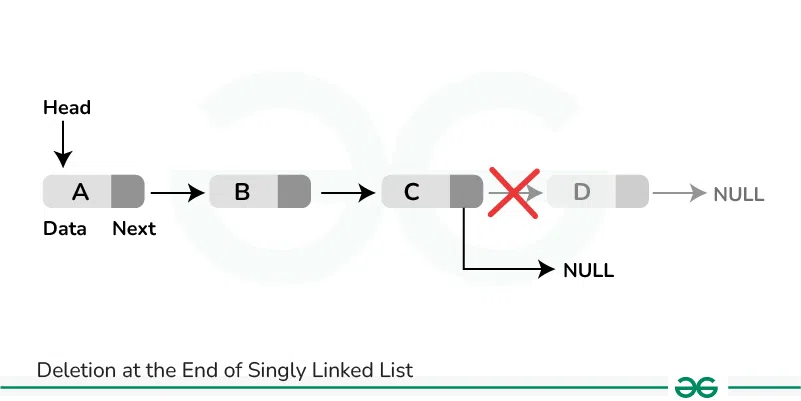Remove last node of the linked list
Last Updated :
22 Feb, 2024
Given a linked list, the task is to remove the last node of the linked list and update the head pointer of the linked list.

Examples:
Input: 1 -> 2 -> 3 -> 4 -> 5 -> NULL
Output: 1 -> 2 -> 3 -> 4 -> NULL
Explanation: The last node of the linked list is 5, so 5 is deleted.
Input: 2 -> 4 -> 6 -> 8 -> 33 -> 67 -> NULL
Output: 2 -> 4 -> 6 -> 8 -> 33 -> NULL
Explanation: The last node of the linked list is 67, so 67 is deleted.
Approach:
To delete the last node of a linked list, find the second last node and make the next pointer of that node null.
Step-by-step algorithm:
- If the first node is null or there is only one node, then they return null.
- if headNode == null then return null
- if headNode.nextNode == null then free
- head and return null
- Create an extra space secondLast, and traverse the linked list till the second last node.
- while secondLast.nextNode.nextNode != null
secondLast = secondLast.nextNode
- Delete the last node, i.e. the next node of the second last node delete(secondLast.nextNode) and set the value of the next second-last node to null.
Implementation:
C++
#include <iostream>
using namespace std;
struct Node {
int data;
struct Node* next;
};
Node* removeLastNode(struct Node* head)
{
if (head == NULL)
return NULL;
if (head->next == NULL) {
delete head;
return NULL;
}
Node* second_last = head;
while (second_last->next->next != NULL)
second_last = second_last->next;
delete (second_last->next);
second_last->next = NULL;
return head;
}
void push(struct Node** head_ref, int new_data)
{
struct Node* new_node = new Node;
new_node->data = new_data;
new_node->next = (*head_ref);
(*head_ref) = new_node;
}
int main()
{
Node* head = NULL;
push(&head, 12);
push(&head, 29);
push(&head, 11);
push(&head, 23);
push(&head, 8);
head = removeLastNode(head);
for (Node* temp = head; temp != NULL; temp = temp->next)
cout << temp->data << " ";
return 0;
}
|
Java
class GFG {
static class Node {
int data;
Node next;
};
static Node removeLastNode(Node head)
{
if (head == null)
return null;
if (head.next == null) {
return null;
}
Node second_last = head;
while (second_last.next.next != null)
second_last = second_last.next;
second_last.next = null;
return head;
}
static Node push(Node head_ref, int new_data)
{
Node new_node = new Node();
new_node.data = new_data;
new_node.next = (head_ref);
(head_ref) = new_node;
return head_ref;
}
public static void main(String args[])
{
Node head = null;
head = push(head, 12);
head = push(head, 29);
head = push(head, 11);
head = push(head, 23);
head = push(head, 8);
head = removeLastNode(head);
for (Node temp = head; temp != null; temp = temp.next)
System.out.print(temp.data + " ");
}
}
|
Python3
import sys
import math
class Node:
def __init__(self, data):
self.data = data
self.next = None
def push(head, data):
if not head:
return Node(data)
temp = Node(data)
temp.next = head
head = temp
return head
def removeLastNode(head):
if head == None:
return None
if head.next == None:
head = None
return None
second_last = head
while(second_last.next.next):
second_last = second_last.next
second_last.next = None
return head
if __name__=='__main__':
head = None
head = push(head, 12)
head = push(head, 29)
head = push(head, 11)
head = push(head, 23)
head = push(head, 8)
head = removeLastNode(head)
while(head):
print("{} ".format(head.data), end ="")
head = head.next
|
C#
using System;
class GFG {
public class Node {
public int data;
public Node next;
};
static Node removeLastNode(Node head)
{
if (head == null)
return null;
if (head.next == null) {
return null;
}
Node second_last = head;
while (second_last.next.next != null)
second_last = second_last.next;
second_last.next = null;
return head;
}
static Node push(Node head_ref, int new_data)
{
Node new_node = new Node();
new_node.data = new_data;
new_node.next = (head_ref);
(head_ref) = new_node;
return head_ref;
}
public static void Main(String[] args)
{
Node head = null;
head = push(head, 12);
head = push(head, 29);
head = push(head, 11);
head = push(head, 23);
head = push(head, 8);
head = removeLastNode(head);
for (Node temp = head; temp != null; temp = temp.next)
Console.Write(temp.data + " ");
}
}
|
Javascript
<script>
class Node {
constructor() {
this.data = 0;
this.next = null;
}
}
function removeLastNode(head)
{
if (head == null)
return null;
if (head.next == null) {
return null;
}
var second_last = head;
while (second_last.next.next != null)
second_last = second_last.next;
second_last.next = null;
return head;
}
function push(head_ref , new_data)
{
var new_node = new Node();
new_node.data = new_data;
new_node.next = (head_ref);
(head_ref) = new_node;
return head_ref;
}
var head = null;
head = push(head, 12);
head = push(head, 29);
head = push(head, 11);
head = push(head, 23);
head = push(head, 8);
head = removeLastNode(head);
for (temp = head; temp != null; temp = temp.next)
document.write(temp.data + " ");
</script>
|
Complexity Analysis:
- Time Complexity: O(n).
The algorithm involves traversal of the linked list till its end, so the time complexity required is O(n).
- Space Complexity: O(1).
No extra space is required, so the space complexity is constant.
Share your thoughts in the comments
Please Login to comment...